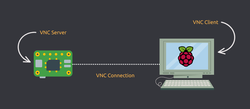today's howtos
-
How to Use Raspberry Pi via VNC - It’s FOSS
Building a project where you need to access the Raspberry Pi remotely?
You can enable SSH on the Pi and access it remotely via a terminal from another system.
However, not everyone is comfortable with the terminal and commands.
An alternative is to access the Raspberry Pi via VNC. This way, you create a remote connection to the Pi and use it graphically like it was connected to your monitor and keyboard.
-
How to install dig, delv, host commands on FreeBSD
FreeBSD default comes with a drill command to see information about DNS. The userspace tools for FreeBSD come from the latest version of the BIND-TOOLs package. It includes delv, dig, host, nslookup, and nsupdate. Let us see how to search and install dig, delv, and host commands on FreeBSD using the pkg command.
-
How to Create LVM Partition Step-by-Step in Linux
In this guide, we will cover how to create lvm partition step-by-step in Linux.
LVM stands for Logical Volume Management, it is the recommended way to manage disk or storage on Linux systems specially for servers. One of the main advantages of LVM partition is that we can extend its size online without any downtime. LVM partition can also be reduced but it is not recommended.
For the demo purpose, I have attached 15GB disk to my Ubuntu 22.04 system, we will create LVM partition on this disk from the command line.
-
Using tcpdump Command in Linux to Analyze Network
Tcpdump is a great tool for analyzing networks and hunting down associated network problems. It captures packets as they go by and shows you what’s going on and coming in on your network. The output from the command displays on the STDOUT and can also be stored in a file.
-
How to install Budgie Desktop in Ubuntu | FOSS Linux
Budgie desktop is an elegant-looking desktop environment developed by the Solus project. This GNOME-based desktop is simple, fast, and easy to use. Also, it is one of the few desktop environments designed explicitly for the Solus OS. Budgies’ philosophy is to offer an easy-to-use desktop environment that is visually appealing and user-friendly.
It was first developed in 2013 by Joshua Strobl, Ikey Doherty, and Solus’s project team as a project to succeed in the GNOME 2 desktop environment. Initially designed for the Solus version of the Linux distro, Budgie can now be incorporated into any Linux distro. The name “Budgie” was taken from the famous Budgie bird.
For those looking for a desktop that is akin to GNOME but with boosted functionality, a few extra features, and a modern look and feel, then Budgie is worth giving a shot at.
-
How to View IP Address on Linux - Linux Nightly
There are several ways to view your system’s IP address in Linux. In this tutorial, you will learn how to see your IP address from command line and GUI.
-
How to Remove and Disable an Individual PPA in Ubuntu 22.04 - TREND OCEANS
In three simple steps, you will be able to disable PPA from your Ubuntu system, and later, you will also learn how to remove any additional PPA from Ubuntu in the following subsection.
-
How to install Tilda Terminal in Ubuntu 22.04 LTS
Tutorial to learn the steps to install Tilda Terminal in Ubuntu 22.04 LTS Linux Jammy JellyFish to replace the default Gnome one.
Tilda is another best free and open-source terminal applications to install and use in Ubuntu Linux. It is available to install using the default APT package manager and repository of Ubuntu. Tilda offers a terminal that can be accessed by pressing a keyboard shortcut (default: Q1 ) open from the top of the screen to the bottom or disappear again. You have a command line ready in seconds, which never stands in the way and also looks good – and that is meant objectively because it is customizable in terms of layout. For that, you will have a long list of options.
Furthermore, tabs are also supported, so that despite many open terminal sessions, everything remains relatively clear. Unfortunately, it is not possible to provide the tabs with their labels.

